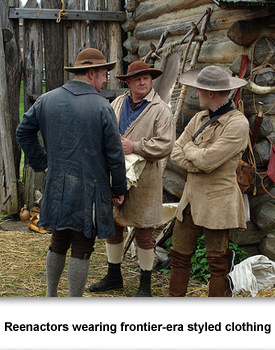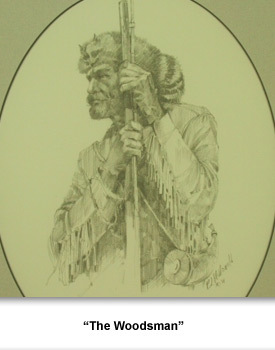Clothing
Men dressed in linen shirts with long tails which also served as night clothes. They wore a vest or waistcoat, knee breeches, and stockings. Most of the garments were made from linen or a combination of linen and wool called linsey-woolsey.
The vest or waistcoat might be made from leather. Daniel Boone, the most famous long hunter, is described as wearing a deerskin hunting jacket dyed black when he came to a settlement in East Tennessee in 1774.
Both men and women occasionally went barefoot in warm weather and wore square-toed shoes or moccasins. Moccasins are a type of shoe, made from deerskin that has been tanned. They were first worn by Indians, then later by long hunters, and frontier families, especially those without a lot of money.
Moccasins were cheap and easy to make. However they did not last long. One French traveler in Illinois complained that his “Indian shoes” only lasted one day causing him to have to mend them every night. Besides being easily torn, the deerskin would soak up water, making them not much better than going barefoot in wet weather.
Moccasins were made from one piece of leather with a connecting seam along the top. They were usually higher at the heel and some had thongs for tying around the ankle. John White’s drawings of Indians in 1585 showed moccasins tied well above the ankle.
Both Indians and long hunters also wore leggings—some leather and others made from wool—that from their ankles to half way up their thighs. Even with all the inconveniences, some people preferred moccasins to shoes of the time. These leather-made shoes weren’t made for right or left feet. They were all made one way and people had to break them in for their right and left feet.
Women wore a wool cape in cold weather, while men had a more coat-like garment called a great coat. Children wore the same type of clothing as their parents.
Both men and women wore straw or simple leather hats to protect their heads outdoors. Women also wore white head -cover-ings called mop caps while indoors. This helped keep their hair clean from the grease and smoke from fireplaces. Unused hats and clothing were usually hung on wooden pegs inserted in the cabin walls.
As families earned more money, their clothing needs increased. After John Buchanan, Sr., was killed on Mill Creek, his estate inventory included two coats, two jackets, two pairs of breeches, a greatcoat, and shoe buckles.
Catharine Lefever was left with two babies when her husband, Isaac, was killed by Indians in 1781. In 1784, a Davidson County jury found her guilty of slander and ordered her to pay a 200 pound fine which she could not.
Her goods were sold at auction and included a red cloak, five calico skirts, six cotton jackets, two robes, silk handkerchiefs, and four yards of black silk, several aprons, six slips, a riding habit (outfit), leather gloves, silk gloves, a chip hat, silk stockings, cotton stockings, four pair of cuffs, two snuffboxes, and a pair of brushes.
This was not enough to pay her fine, so Catharine was sent to jail, while her two children were bound over to serve as servants to a household until they were 18 years old.
Picture Credits:
- A photograph of reenactors wearing frontier-era styled clothing. Frontiersmen combined both the standard dress commonly worn by all men during the 18th century like knee breeches and overcoats as well as items worn by Indians like leather moccasins as worn by the man on the left. Photograph taken at Mansker's by Robert Neidlinger. Used with his permission
- Drawing entitled, “The Woodsman.” This drawing was created by R. J. McDonald in 1981. It shows a frontiersman wearing a coonskin cap and a jacket made of buckskin. He is also shown carrying a flintlock rifle and powder horn. Tennessee State Museum Collection, 2007.204.25
Frontier >> Living on the Frontier >> Everyday Life >> Clothing


 Sponsored by: National Endowment for the Humanities
Sponsored by: National Endowment for the Humanities